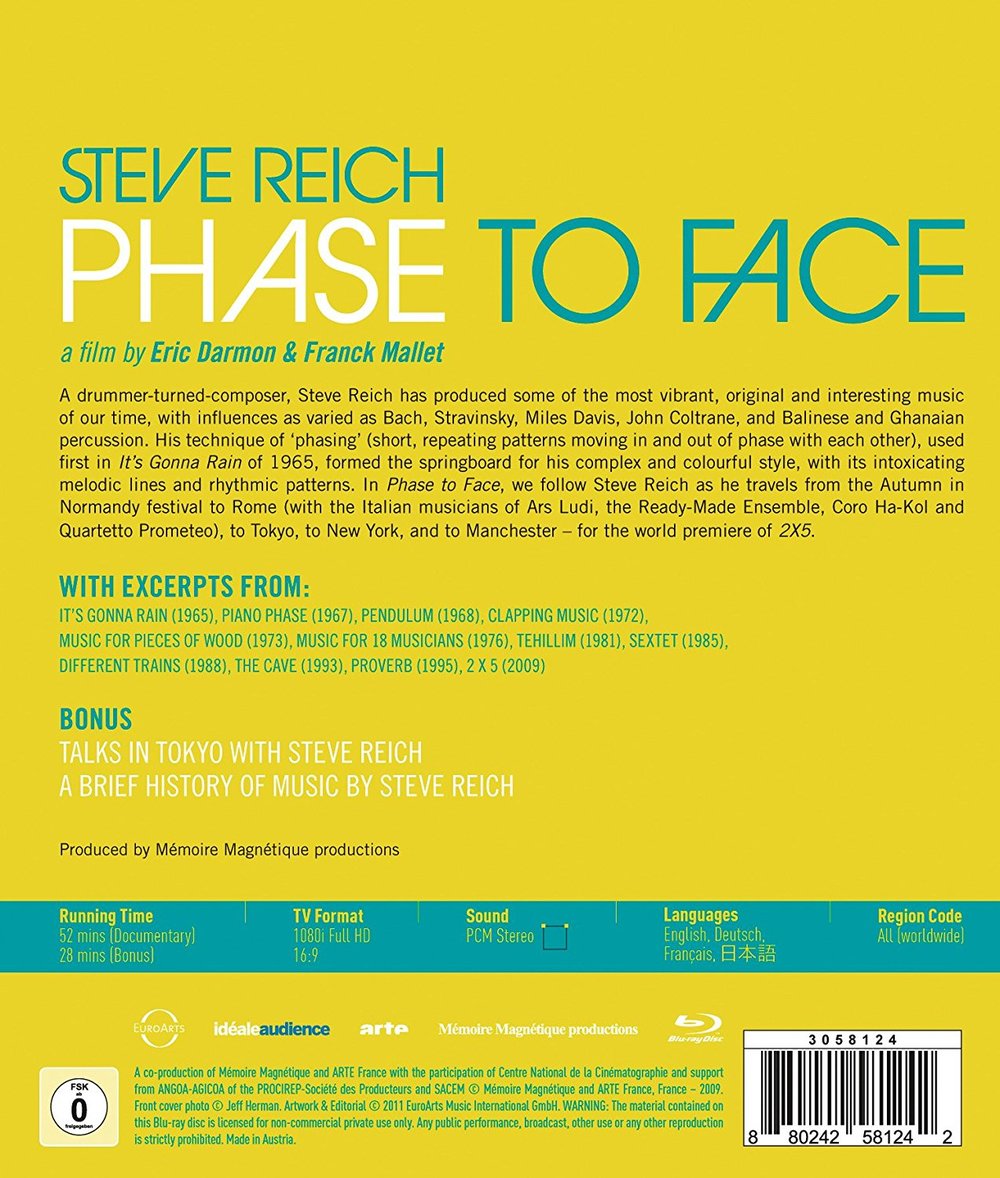

Steve Reich Phase to Face film by Eric Darmon and Frank Mallet. This is a documentary film detailing the career and music of Steve Reich. Includes bonus featurettes Talks in Tokyo with Steve Reich and A Brief History of Music by Steve Reich Grade: B
This title has stereo sound only. We normally don't cover discs with only stereo. But we sometimes make exceptions for documentary films that would not benefit from surround sound.
For the novice just getting into classical music, it may seem, on first glance, that classical music is dead. Not dead in the sense that it isn't being played, performed, and loved by millions of people, but dead in that seemingly no new classical music is being written. One need only visit this site to see that the interest for watching classical music exists. But an inspection of the titles shows that the music being played is distinctly older. While there are plenty of new ballets being produced and new operas being performed, it seems that new classical music is highly underrepresented.
But as the novice digs further, he will find that modern classical music does exist. It just doesn't sound much like the works of Beethoven or Mozart. A fine example of this is the work of Steve Reich. A modern, minimalist composer, he has been writing and performing from the mid-1960s and is still composing today. His work is marked by the use of phasing - a technique where two of the same instrument play the same piece of music, at steady but not identical tempos. The result is a sound unlike most in the classical tradition. This technique, and Reich's works, have been highly influential in the direction of modern classical and popular music. When the history of late 20th century music is written, Reich's name will appear as one its key figures. Here are a few screenshots of Reich in his trademark olive baseball cap:
The film itself is only about 50 minutes—a bit on the short side. But both the topic and the man himself are so engaging that the running time is an afterthought. The film follows Reich as he travels the world from concert to concert and into recording studios where he continues to perform new music. Interspersed between the concert footage are sections with Reich discussing his life and influences. He discusses several of his most well regarded works, namely Music for 18 Musicians and Different Trains, as well as other pieces. While not exhaustive in detail, there is definitely enough to get a feel for the type of music Reich composes. Here are a few shots of the types of musical interludes in the film—both live performances and video montages made for the film:
It's impressive to see and hear Reich himself talk about his own life's work. This will preclude a lot of discussion later about what Reich was trying to do. I was especially interested in Reich's comments the “Brief History of Music” extra feature. Reich explains that he is working as a successor to Bach, the classical composers, Debussy, Ravel, Stravinsky, and Copeland in that he is merely introducing new methods based on traditional concepts of tonality and rhythm. Stated differently, he states he does not belong the de-constructionist school of Schoenberg and his followers.
This documentary suggests that Reich puts a lot of emphasis in this career on providing video content to augment his music. This should appeal to HDVD fans! For example, see 14:39 where Reich got interested in a street preacher shouting out about how It's gonna rain! You hear this on a taxi cab radio—and you see the text on the taxi meter! It took some work to get that shot! Later at 16:31 the preacher is shown with some sophisticated artwork. Then at 18:24, there are two dancers (and their shadows) choreographed by Anne Teresa de Keermaeker in an "out-of-phase ballet." At 36:10, in the Different Trains segment, there is clever artwork including a display of the notes being played and the lyrics appear on street signs. Sometimes it's difficult to see if this emphasis on visuals was there at the beginning or added by the documentary film makers. But in The Cave segment [Track 8], we can see that the original production included big screen visuals and text displayed on the screens in three languages. And in the Theater of Voices segment beginning about 50:34, Reich seems to be starting a new career in the art of typography.
I'll point out that we do have some modern music in HDVD. The works of Tōru Takemitsu reminds one a bit of Reich because Tōru was another percussionist who was interested in serendipitously "found" sound. From him we have the My Way of Life concert spectacular and the just released From me flows what you call time. We also have the Tributes-Pulse recording from Decapo which in part is a tribute to Steve Reich. Finally, we have several titles that might be considered to be from the de-constructionist school: the Ives Holidays Symphony and the Boulez Notations for Orchestra.
My only disappointment with this disc is that there is no extra of a complete performance of one of Reich's works. If this documentary does well in the market, perhaps HDVD producers will be encouraged to release complete concert discs. But I'm aware that this disc is advertised as a documentary only. As such it teaches the novice much about Reich and the future of classical music, and it deserves the grade of B.
OR






